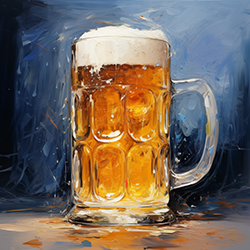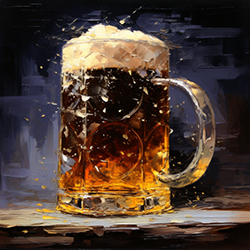The Science Behind How Mash Temperatures Craft Your Beer's Flavor Spectrum
Posted by Matteo Lahm on 6th Jan 2025
How well do you control your mash temperatures? The key is a careful balance between your chosen malt and the precise temperature at which you mash it. Grab your brew paddle. Let's embark upon the sea of brewing science, and just like a ship needs a compass, a beer maker needs a good thermometer.
Your malt is a delicate balancing act. It's a very sensitive scale that can sway your beer's flavor profile in one direction or another with just a slight change in temperature. The type of malt you choose significantly impacts this dynamic.
There's a wide array of malts to choose from, each with its unique characteristics. From the light and delicate Pilsner malt, perfect for a crisp, refreshing lager, to the robust and dark Chocolate malt, ideal for a rich, full-bodied stout. Your choice of malt is the first step in defining your beer's identity, and how you will mash it.
But choosing your malt is only half the equation. The temperature at which you mash your malt is equally crucial. It is the counterweight.

The mash temperature determines which enzymes in the malt get activated, and these enzymes, in turn, determine the type of sugars produced. Lower temperatures favor beta-amylase enzymes, which produce simpler sugars that yeast can easily ferment, resulting in a drier beer. Higher temperatures favor alpha-amylase enzymes, which produce larger sugar molecules that yeast can't fully ferment, leading to a sweeter, fuller-bodied beer.
So, the type of malt you choose and the temperature at which you mash it are the two key factors that will determine the flavor of your beer. With a bit of practice and attention to detail, you can master it and brew beers that are truly your own.
If you're aiming for a light, crisp beer like a Pilsner, you'll want to use Pilsner malt and mash at a lower temperature, around 145°F. This lower temperature activates enzymes called beta-amylase, which break down the malt's starches into simpler sugars that yeast can easily ferment. The result? A drier beer with a clean, crisp finish.
For a medium-bodied beer like an Amber Ale, you'll want to use a combination of base malt and specialty malts like Crystal or Munich. Mash these at a moderate temperature, around 152°F. This temperature is a sweet spot that activates both beta and alpha-amylase enzymes, resulting in a mix of fermentable and non-fermentable sugars. The result? A beer with balanced sweetness and body.
On the other end of the spectrum, if you're going for a rich, full-bodied beer like a Stout, you'll want to use a combination of base malt and specialty malts like Chocolate or Roasted Barley. Mash these at a higher temperature, around 158°F. This higher temperature activates a different enzyme, alpha-amylase, which produces larger sugar molecules that yeast can't fully ferment. The result? A beer with residual sweetness and a fuller body.
Now, let's address the boundaries of this brewing process. The absolute minimum temperature for mashing is around 140°F. Below this, the enzymes, which are proteins that speed up chemical reactions, won't activate properly. This is because these enzymes need a certain amount of heat to kickstart their work of breaking down the malt's starches into sugars. If the temperature is too low, they can't do their job effectively, leaving you with a beer that's thin and lacking in flavor.
On the other hand, the absolute maximum temperature is around 170°F. Above this, you risk denaturing the enzymes. Denaturing is a process where the enzymes lose their structure due to excessive heat, and as a result, they lose their ability to function. When the enzymes are denatured, they can't break down the starches into sugars, which means the yeast won't have enough food to produce alcohol.
The result of this is a beer that's overly sweet and cloying. The term "cloying" refers to an overly sweet taste that is unpleasant and can make the beer feel heavy and unbalanced. It's like adding too much sugar to your coffee; it overshadows the other flavors and leaves an unpleasant aftertaste.
So, maintaining the right mash temperature is crucial in brewing. It's about finding that sweet spot where the enzymes can do their job effectively, resulting in a beer that's balanced and full of flavor. In the world of brewing, precision is key, and this is where the importance of a high-quality thermometer comes into play. Just as a compass guides a sailor through the vast ocean, a reliable thermometer guides a brewer through the intricate process of mashing. It's an essential tool in your brewing arsenal, one that ensures you hit the right temperatures and maintain them throughout the mashing process.

You might think, "What's a few degrees here or there?" But in brewing, a difference of even 5 degrees can have a significant impact on your final product. Remember, each enzyme in your malt has a specific temperature range at which it works best. A slight deviation from this range can affect the enzyme's ability to break down starches into sugars, which can, in turn, affect the flavor, body, and overall balance of your beer.
For instance, mashing at a temperature that's 5 degrees lower than optimal can lead to a beer that's drier and thinner, as more simple sugars are produced that the yeast can fully ferment. On the other hand, mashing at a temperature that's 5 degrees higher can result in a beer that's sweeter and fuller-bodied, as more complex sugars are produced that the yeast can't fully ferment.
So, investing in a high-quality thermometer is not just about getting accurate readings. It's about gaining control over your brewing process, being able to fine-tune your recipes, and ultimately, being able to brew beers that are technically accomplished. After all, brewing is as much a science as it is an art, and a good thermometer is one tool that helps you master both.
Understanding the role of enzymes and how they interact with different temperatures is crucial. Each enzyme has its own preferred temperature range. Stray too far from this range, and you risk either under-activating the enzymes, leading to a thin, flavorless beer, or denaturing them, resulting in an overly sweet, unbalanced brew.
Investing in a high-quality thermometer is not just a luxury, but a necessity in the brewing process. A few degrees might not seem like much, but consider that water is liquid at 33 degrees and ice at 32. A ship making a thousand mile journey will be far from its desired destination if the trajectory is off by just a degree or two. That should give you a good comparison to show just how much accuracy matters. A reliable thermometer gives you the control to fine-tune your brewing process, helping you achieve the perfect balance of flavors in your beer.
So, as you start your next batch, remember the importance of balance - in your choice of malt, in your mash temperature, and in your final brew. With a bit of practice and experimentation, you can take your beer making to the next level. Happy brewing!

